Maxvorstadt - urban area located in the center of Munich.
Maxvorstadt since 1992, after the reorganization of the urban areas of Munich, consists of three former districts: Munich University (Maxvorstadt-Universität), Munich-Königsplatz-Mansfeld and Maxvorstadt-Josefsplatz.
Munich was conceived as the expansion of the city in the period between 1805 and 1810, with the king of Bavaria, Maximilian I Joseph, after whom the area got its name. Largely Maxvorstadt was built after 1825 in the classical style when Ludwig I.
Today, Munich is an important and one of the most visited places in the Bavarian capital with its many sights, historical buildings, parks, squares and Royal avenues.
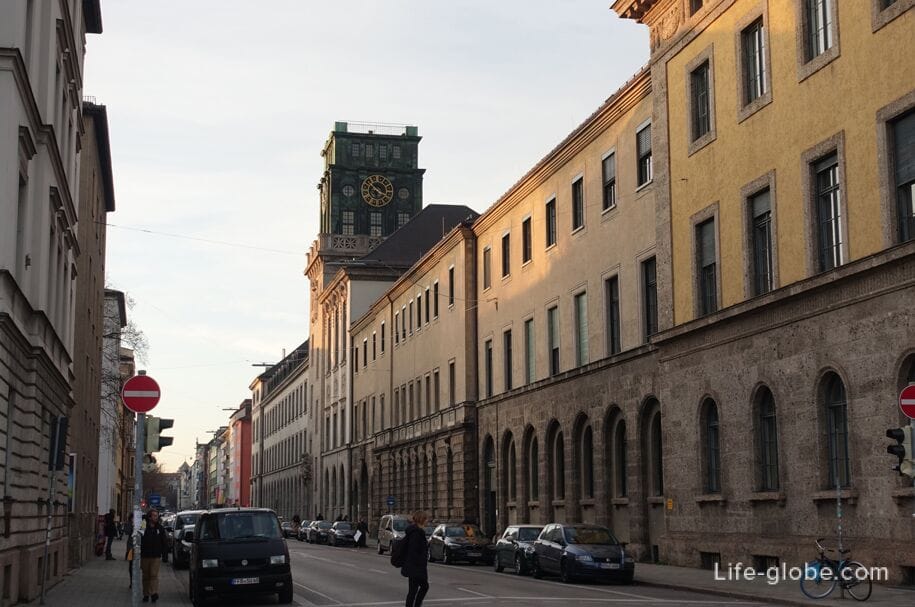
The area is known primarily as a place of culture and science. Within it are some of the most famous museums in Munich, as well as theatres, government agencies, educational and research institutions: the Munich Academy of arts, Ludwig-Maximilian University, a Roman Catholic Seminary, the University of music and theatre in Munich, the Munich University of philosophy, Munich technical University, graduate school of film and television Munich, Bavarian state library, etc.
The Munich Academy of fine arts
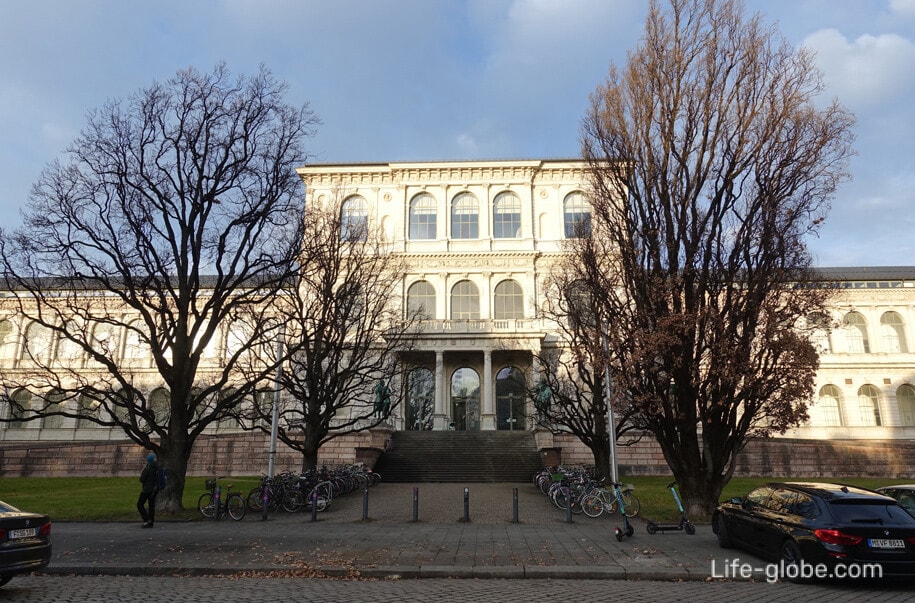
The Roman Catholic Seminary
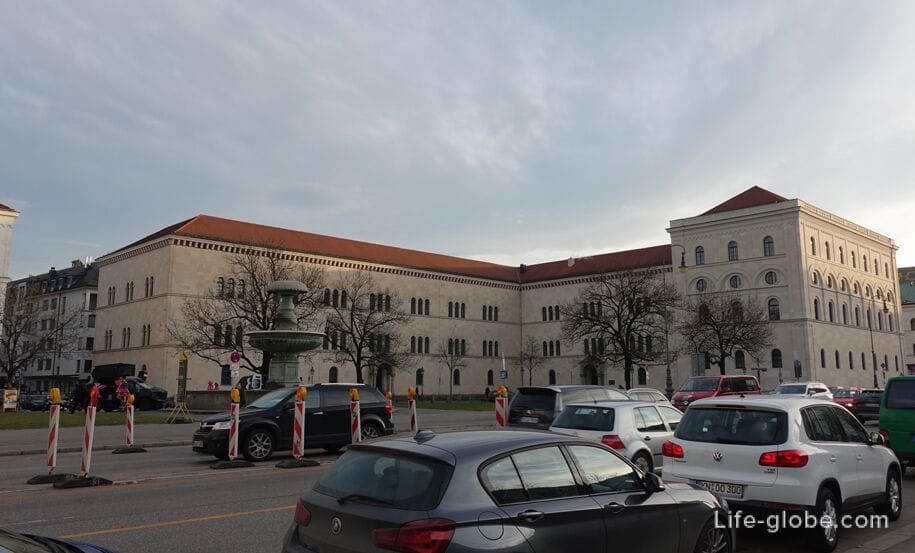
Ludwig Maximilian University

Department of technical University
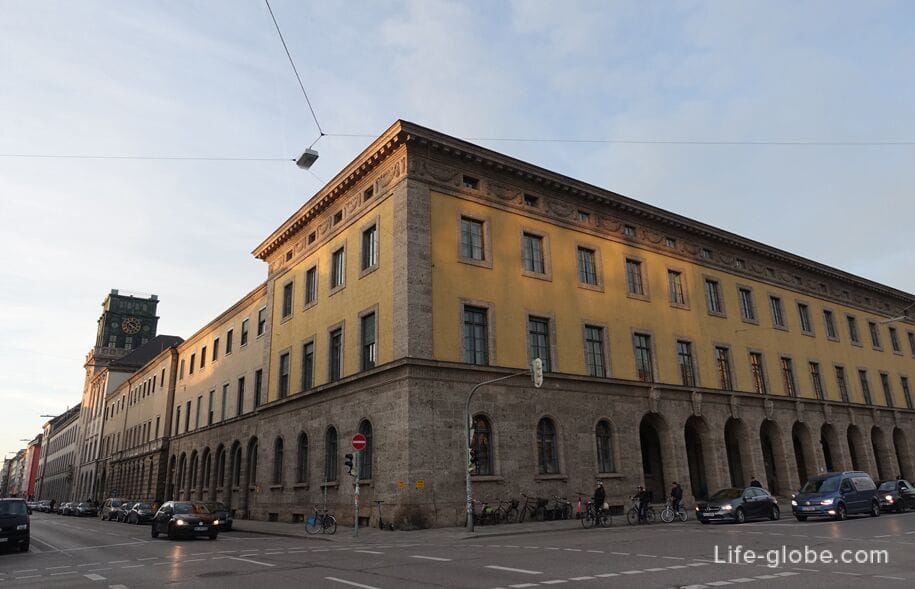
The area of art in Munich (museums)
The area of art (Kunstareal München / Kunstareal) - art area, the Museum quarter and the cultural center of Munich known outside of the city (in Bavaria and in Europe) and representing the area in which are concentrated important museums and galleries of the city:
- Old Pinakothek (Alte Pinakothek) Museum with a collection of paintings by masters from the middle Ages to the mid-18th century;
- New Pinakothek (Neue Pinakothek) Museum, which presents paintings and sculptures by artists of the second half of the 18th - early 20th centuries;
- The Pinakothek of modernity (Pinakothek der Moderne) is one of the largest art museums of modern art, mainly 20th and 21st century;
- Museum Brandhorst (Brandhorst Museum) - art Museum dedicated to contemporary art since the late 1950-ies to the present day;
- Museum of Egyptian art (Staatliches Museum Ägyptischer Kunst) - the archaeological Museum, containing the Bavarian state collection, which focuses on the art of ancient Egypt;
- Glyptotek Museum is a Museum with collection of ancient sculpture and glyptic;
- State antique collection (Staatliche Antikensammlung), the Museum, which houses one of the most extensive collections of antiquities Greek, Etruscan and Roman art in Germany;
- city gallery at the Lenbach house (Lenbachhaus Städtische Galerie im) - art Museum collection of works by Munich artists, especially the 18th - 19th centuries. The gallery is located in the former house-Villa of the German portrait painter Franz von Lenbach (1836-1904) was with a modern annexe;
- geological Museum, dedicated to the rocky history of Bavaria, the geological processes and cycles that change earth's crust and raw material resources of our planet;
- paleontological Museum dedicated to the history of Earth and life, showing fossils of plants and animals of the eras of earth's history;
documentation center Nazi party (NS-Dokumentationszentrum), focusing on the history and consequences of the Nazi regime and the role of Munich as the "capital of the movement" national socialism;
Museum of casts of classical images (Museum für Klassischer Bildwerke Abgüsse) - gallery with a collection of plaster copies of famous ancient Greek and Roman sculptures (statues and busts from 700 BC to 500 BC), which was reproduced in conformity with the originals;
Museum "Kingdom of crystals" (Museum Reich der Kristalle), which is the collection of minerals and fossils, including diamonds, emeralds and other precious stones and minerals. There are also collections of meteorites, quartz from Alpine and Bavarian minerals from ore deposits. Read more about Area arts and museums...
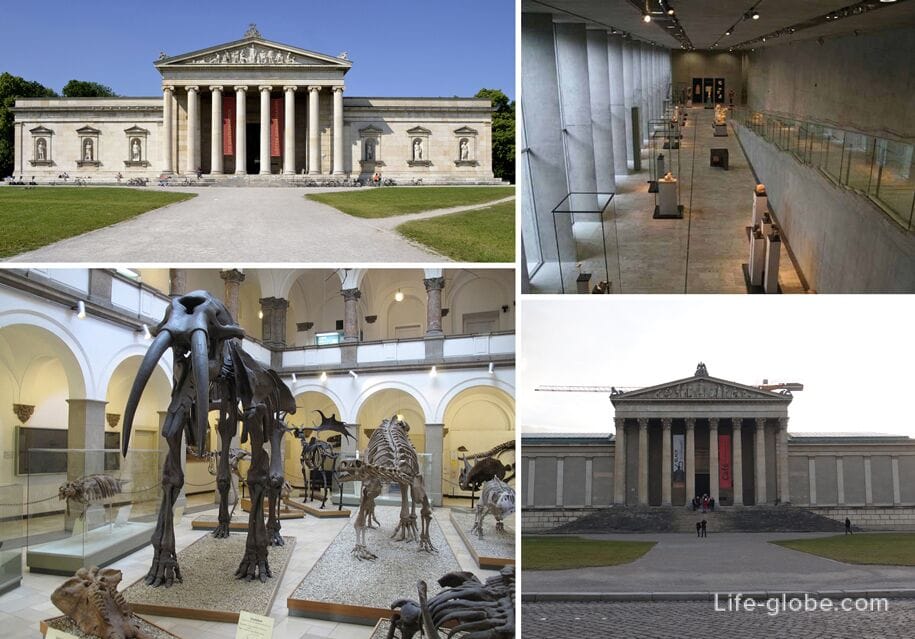
The main squares of Munich
Royal square
Royal square (Königsplatz / Königsplatz) was created in the style of European classicism in the 19th century the German court architect Leo von Klenze by decree of the Bavarian crown Prince Ludwig I as the "Place of culture".
At the Royal square located:
- Propylaea (Propyläen) is a historical monument, which is a former gate (the front passage), erected in 1862.
- The Glyptothek and the State antique collection. Read more about Royal square...
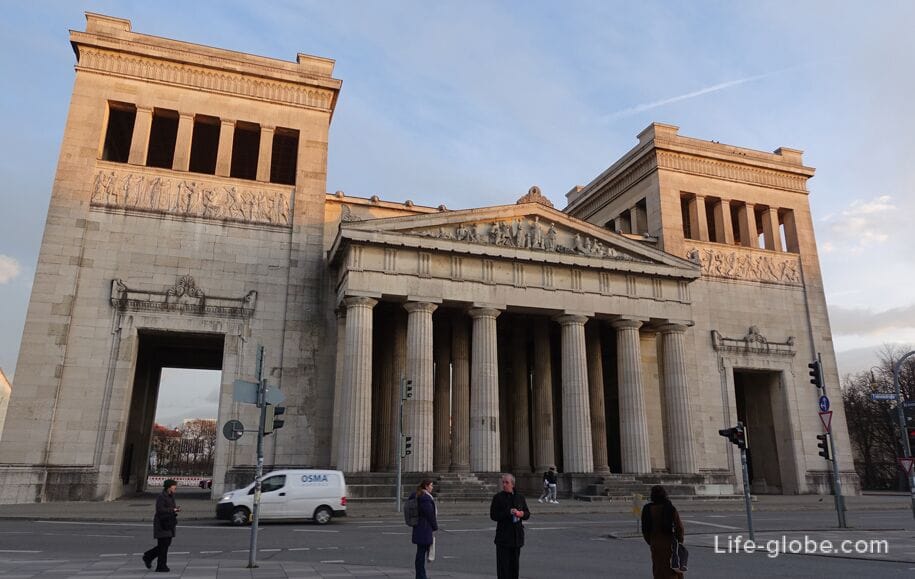
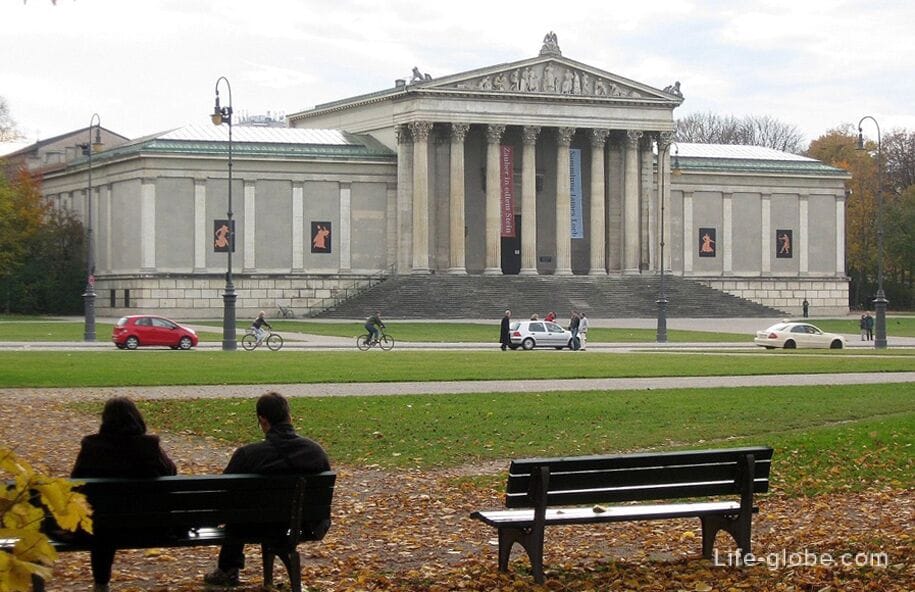
Karolinenplatz
Square Karolinenplatz (Garage) was built by analogy with the Paris Star square and named after the second wife of king Maximilian I Princess Caroline of Baden.
The area is known primarily due to the high 29-metre-high obelisk that stands in the center of the square and is called "Obelisk of Karolinenplatz" (Obelisk Karolinenplatz am).
The obelisk was erected in 1833 as a memorial to soldiers of the Bavarian soldiers who perished in the Russian campaign of Napoleon in 1812. Read more about Karolinenplatz and the obelisk...
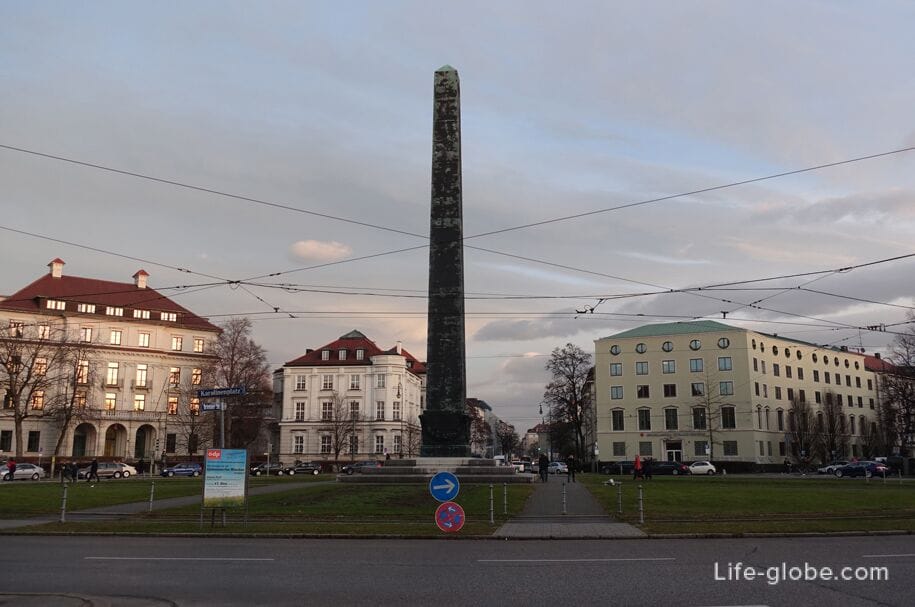
Area Of Wittelsbach
Area of Wittelsbach (Wittelsbacherplatz the / Wittelsbacherplatz) is the most beautiful square in the classical style in Munich.
Its current name the area was in 1827, when it was named in honor of one of the oldest noble families of Wittelsbach.
The center of the square is decorated with a bronze equestrian statue of the elector Maximilian I, and is concentrated around the area's historic buildings, including former palaces. More about area of Wittelsbach...

Royal avenues in Munich
In the 19th century in Munich was built four Royal Avenuethat led from the city centre. Two of the four avenues is located in Maxvorstadt.
Brienner Strasse
Briennerstrasse (Brienner Straße) was built in the neoclassical style with 1812 in accordance with the plans of Karl von Fischer and Friedrich Ludwig von Scala.
Street Brienner stretches from the Northern edge of Munich's old town (the square Odeonsplatz underground station) in a North-westerly direction to Nymphenburger straße (Nymphenburger Straße).
The length Briennerstrasse is about a mile.
Along the street are located buildings, some of which are significant historic sites - former mansions of the nobles of Munich as well as museums, shops and restaurants. Read more about Avenue Brienner Strasse...
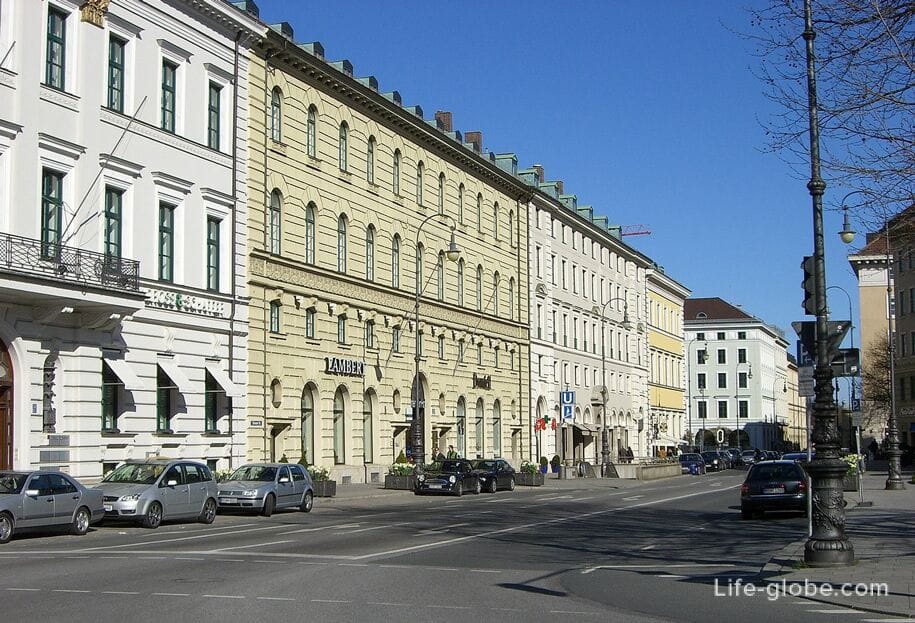
Ludwigstraße
Ludwigstraße (Ludwigstraße) was built on the initiative of king Ludwig I of Bavaria (and named in his honor), starting in 1816 as a "great" street, representing the Bavarian Kingdom.
The length of the street is just over 1 kilometer, it stretches from the square Odeonsplatz is absolutely right in a North-easterly direction and ends at the gates of Victory.
The main objects on ludwigstraße: the building of Bavarian archival Bureau, building of the Bavarian state social court, the Bavarian state library, the Church of St. Louis Roman Catholic Seminary, the University Ludwig-Maximilian, fountains, memorial White rose and the Victory gate - a majestic arch, dedicated to the glory of the Bavarian army. Read more about ludwigstraße...
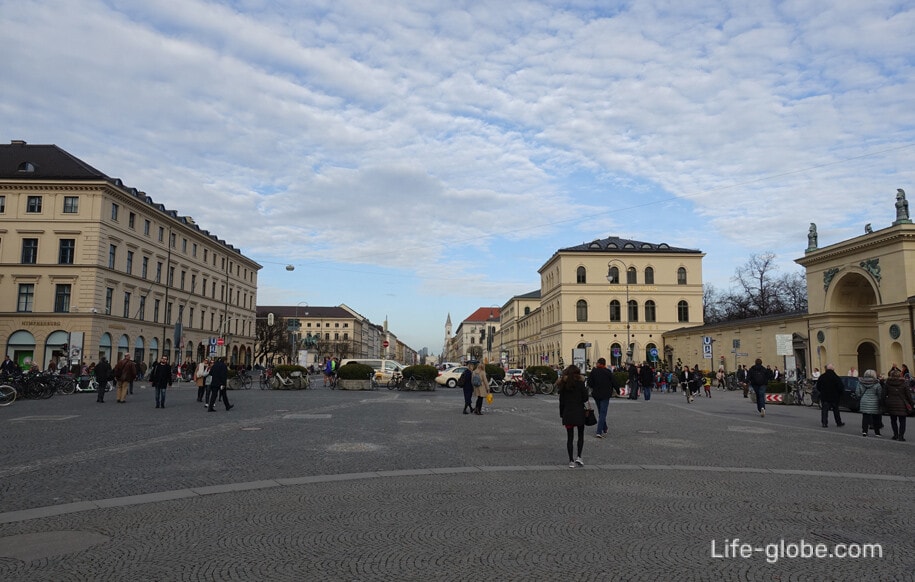
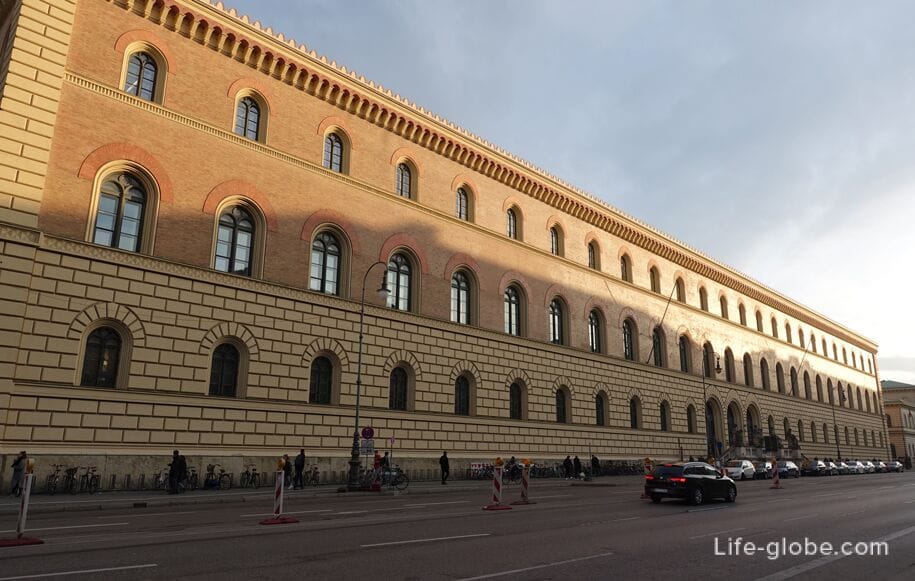
Street Richard-Wagner-straße
Richard-Wagner-straße underground station (Richard-Wagner-Straße) - unextended street, having a length of about 300 meters and located in the heart of Maxvorstadt.
The street was built in 1897 in the course of planned development of Maxvorstadt and named in honor of the composer Richard Wagner, who lived in the area in the years 1864-1865, at: Brienner Strasse 37.
House of the street was built between 1899 and 1906, mostly by the architect Leopard Romasa. In the design of the street, the architect used various architectural periods, taking into account the taste of late historicism, with the aim to create the impression of "historic" street.
The proximity to the Royal square was made outside the place of residence of upper middle class of Munich.
To this day preserved some historic buildings that create a picturesque architectural ensemble. It is such houses as: the rear part of the gallery of Munich, the building of the paleontological Museum in the Baroque style (house number 10); a residential house in the style of neo-Renaissance and art Nouveau neogotiki numbered 5, 7, 9, 11, 13, 15, 17, 18, 19 and 27; Municipal kindergarten "Frederick Sidel" (number 14); student residence Fund van Caulker (number 16).
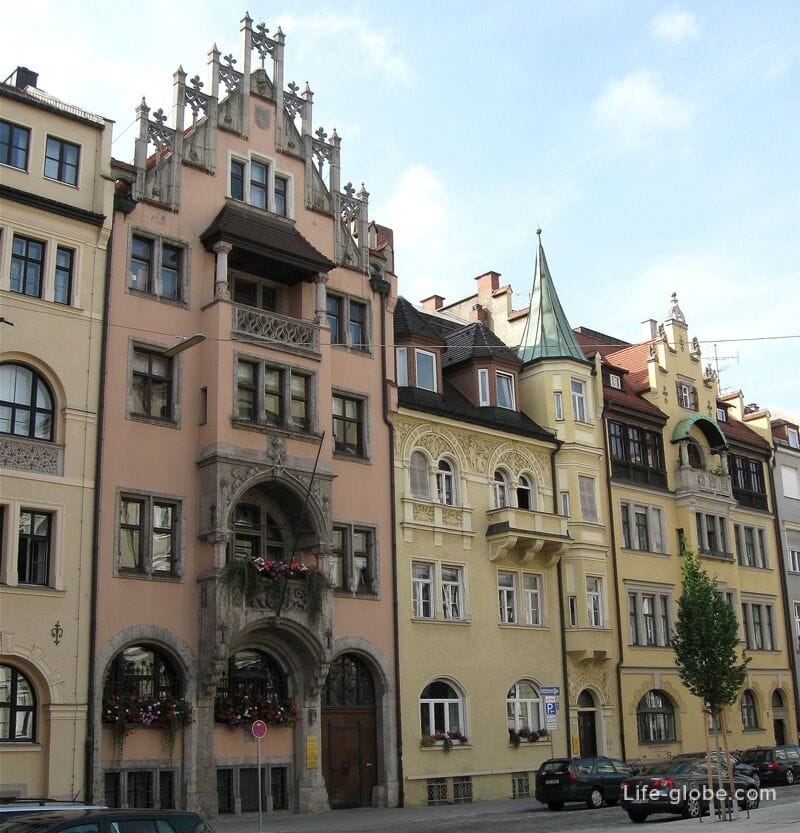
Old Botanical garden with its Neptune fountain
Old Botanical garden (Alter Botanischer Garten) is located near the square Lenbach (Lenbachplatz) and is currently a public Park.
The Botanical garden was created between 1804 and 1812 years, according to the plans of a landscape architect Friedrich Ludwig von Scala.
In 1914 near the Nymphenburg Palace, on the former outskirts of Munich, have established a new Botanical garden. In 1937 by architect Poul Ludwig rope-hauled light and the plans of the architect Oswald Bieber and sculptor Joseph Wekerle already by the time the old Botanical garden was turned into a Park.
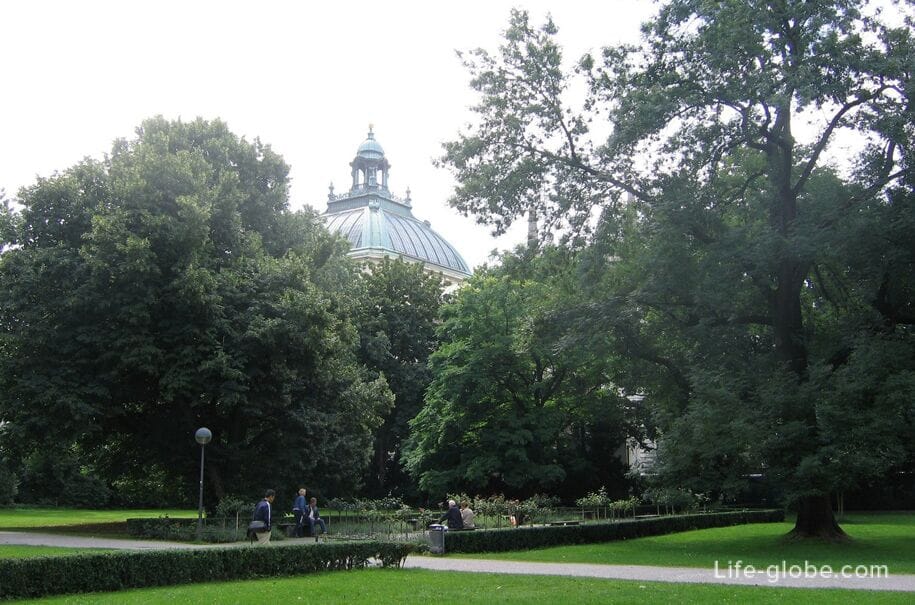
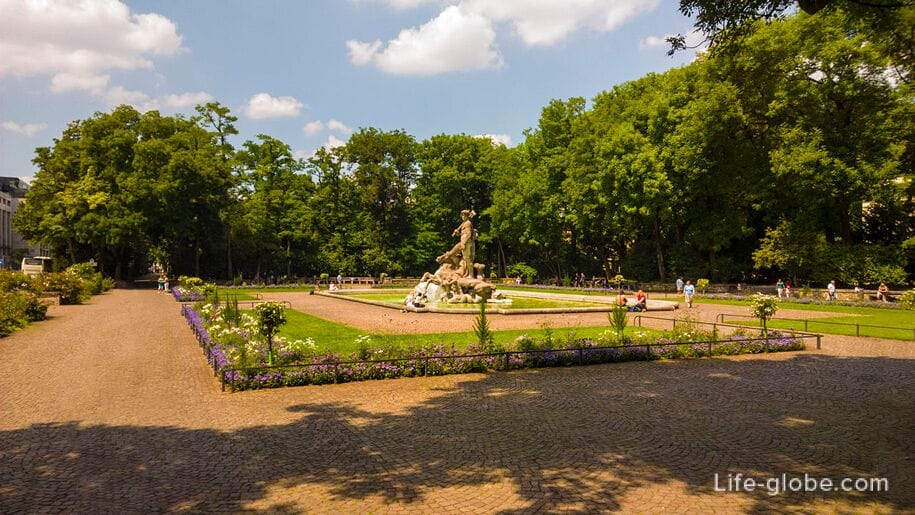
Today the Park are:
fountain of Neptune (Neptunbrunnen / Neptunbrunnen), created in 1937 according to the plans of the sculptor Joseph Wekerle and architect Oswald Bieber.
The fountain is 30 meters long and 15 meters wide. In the center of the bowl of the fountain a sculptural composition consisting of the statue of Neptune, holding on the shoulder of the Trident and rises above the horse with a fish tail rising from the water. Near the horse and depicts Neptune's tritons, from which water pours into the pool of the fountain;
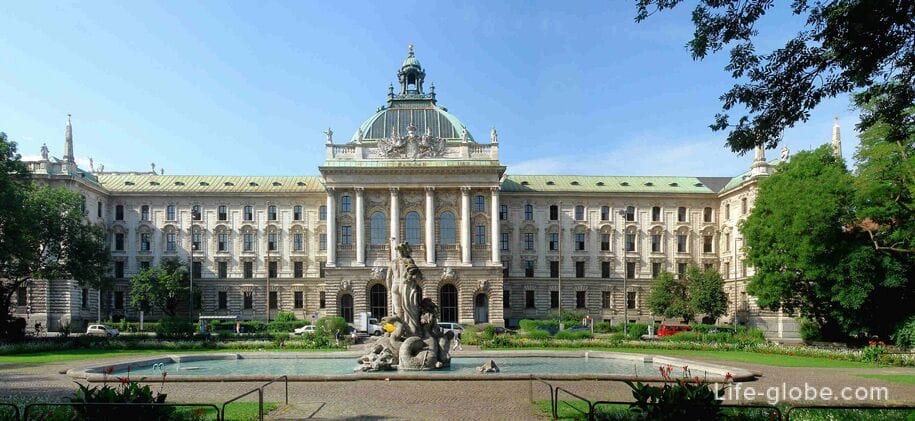

art pavilion (Kunstpavillon), created as an exhibition space in 1936 by the architect Oswald Bieber on the site burned down in 1931, the glass Palace. Website: kunstpavillon;
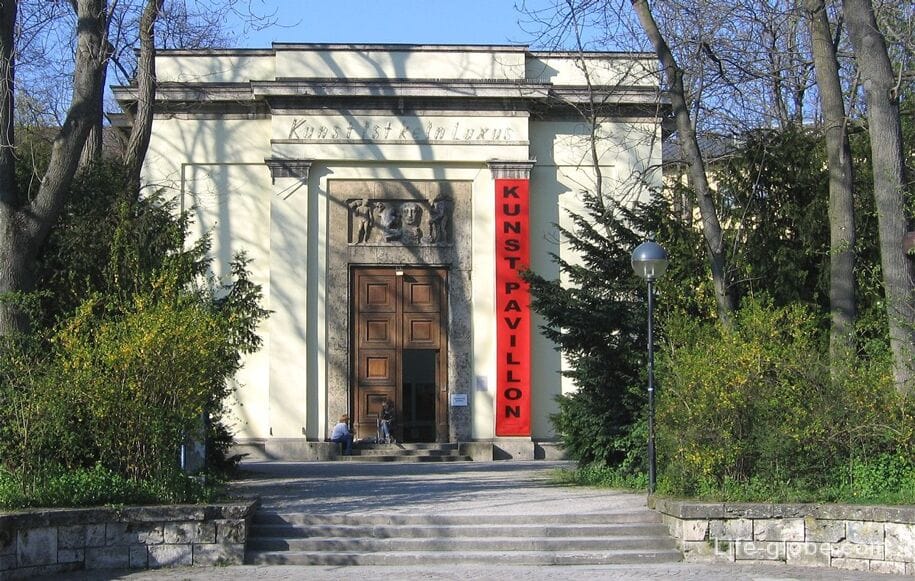
memorial the world's first transmission line over large distances Miesbach to Munich in 1882;

cafe in the historic style of today's "Park Cafe" with a courtyard with beer garden.

Other important objects in Maxvorstadt
Turkish gate
Turkish gate (Türkentor / Tormentor) is the only remaining small part (door gate) from the former Turkish barracks in Munich, built in 1826 for the Royal Bavarian infantry lifeguards regiment.
In the period from 2008 to 2010, Tarkenton was revived under a modern building given its historical significance and re-opened in October 2010.
The room is the sculpture "Large Red Sphere" (Large Red Sphere), by the American artist Walter De Maria. Admission is free (complimentary).
Address gate: Turkenstrasse, 17 (Türkenstraße).
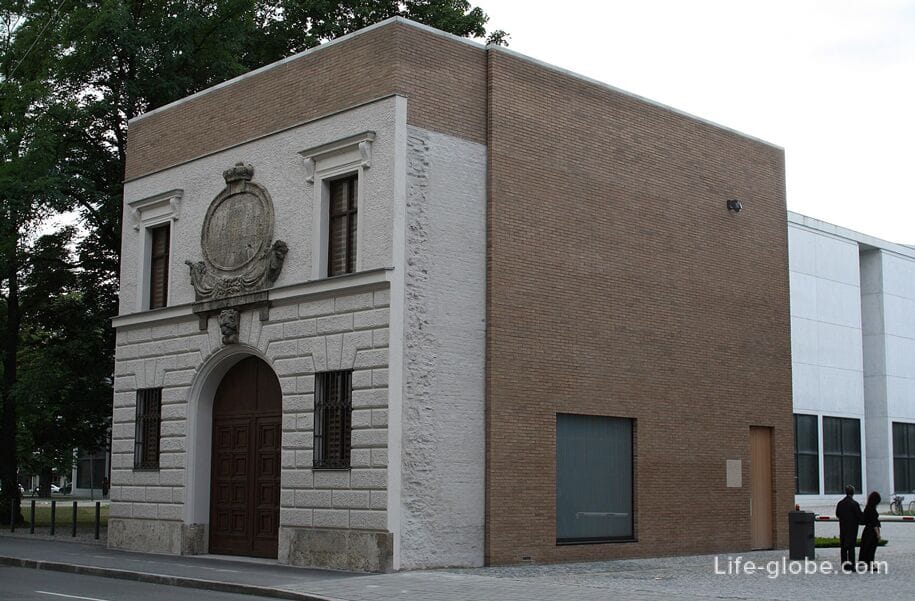

Palace Duerkheim
Palace duerkheim or Durkalski Palace (Palais Dürckheim) - a building in the classical style with a facade of brick, with elements of Sandstone and reliefs.
The Palace was built from 1842 to 1844 the years by the architect Franz Jacob Kreuter commissioned by the Royal Chamberlain and the chief steward, the count Friedrich Wilhelm Alfred von Durkheim-Monmartre.
From 1855 to 1909, the Palace was the residence of the Prussian mission in Bavaria. From 1937 to the end of the Second world war it was used as a police hospital. After reconstruction, the building was a State criminal police office until 1968, and later the training center of the Bavarian state Bank, from 2006 to 2014 years, the building was a center for the dissemination of art and art education "Palace gallery".
Address: Turkenstrasse, 4 (Türkenstraße).
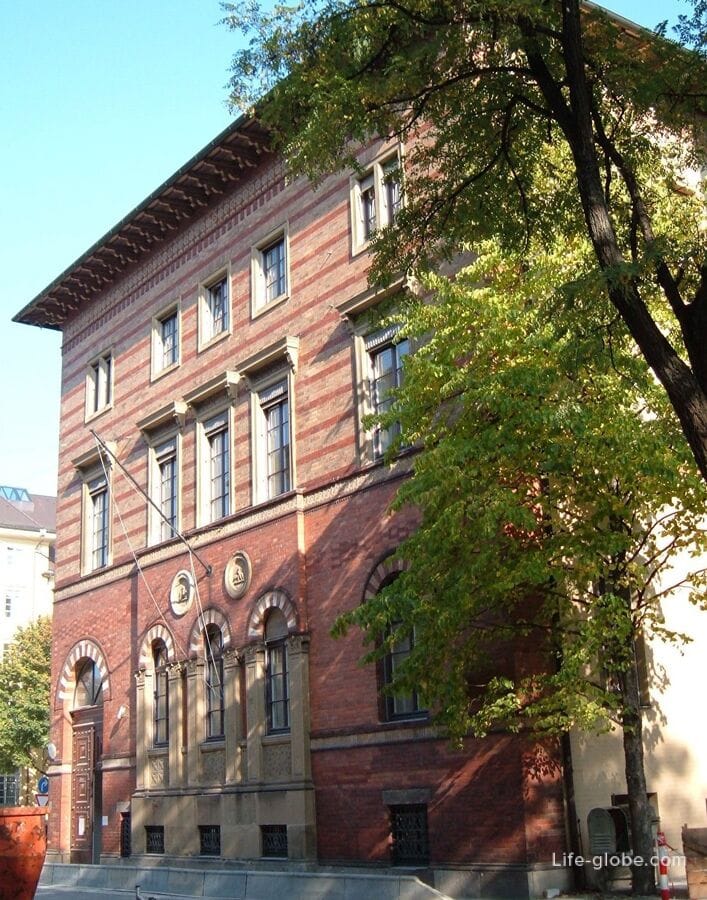
Villa Kaulbach
Villa Kaulbach (Kaulbach Villa) was built in neo-Renaissance style between 1887 and 1889 by architect Gabriel von Seidl's as representative of the house of the painter Friedrich August von Kaulbach.
Today the building is the seat of the Historical College (Historisches Kolleg).
Address: Kaulbachstrasse, 15 (Kaulbachstraße).
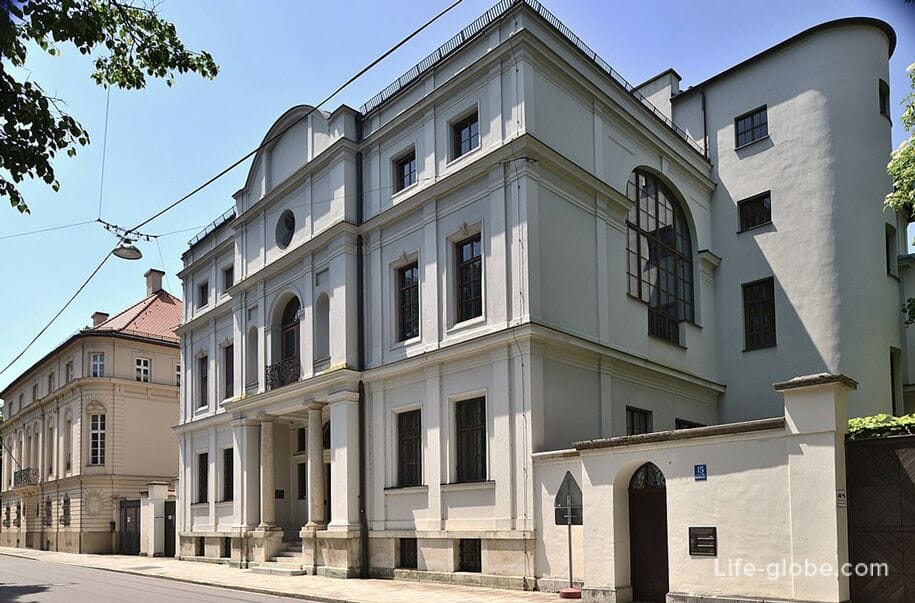
The Palace Of Justice
Neo-Baroque Palace of Justice (cocktail lounge and a library) was built in 1890-1897 years by the German architect Friedrich von Tarsem.
The architecture of the building is dominated byfour of the facade, the Central glass dome (67 m) and sculptures located on the facades and the roof of the building. The center of the building, which was designed around two courtyards, is the Central hall 19х29 meters.
Today, the walls of the structure are the Bavarian Ministry of justice and the district court I of Munich.
Address: Karlsplatz / Premiertrade, 7 (Prielmayerstraße).
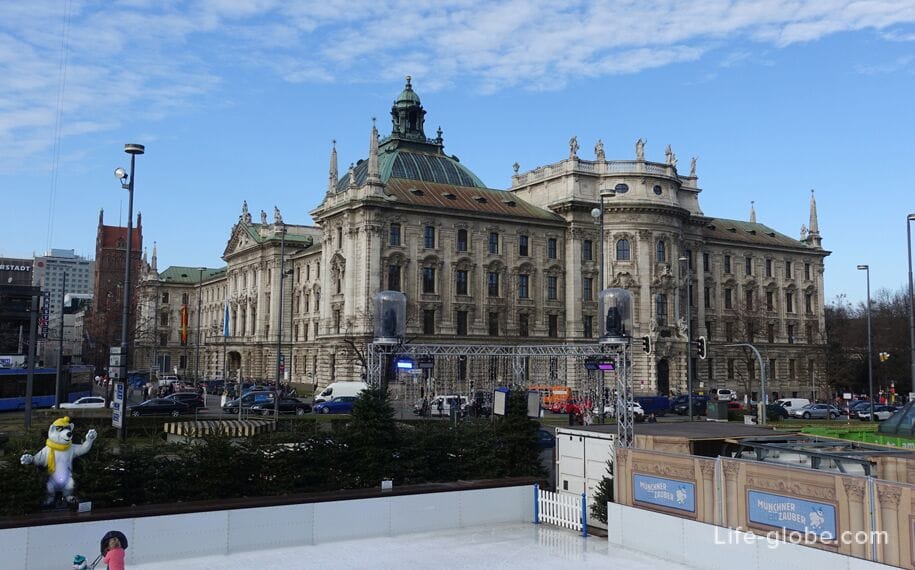
New Palace of Justice
New Palace of justice (New cocktail lounge and a library) was erected in addition to the already existing Palace of justice, since the latter is not enough space.
The building was designed by Friedrich von Tarsem in 1905, in strong contrast with the "old" Palace of Justice, of red brick in Northern neo-Gothic style with two towers. End facades are marked with high-stepped Gables, and the Central docking tower on each side bordered by similar Gables.
Today the building houses the Higher regional court.
Address: Premiertrade, 5 (Prielmayerstraße).
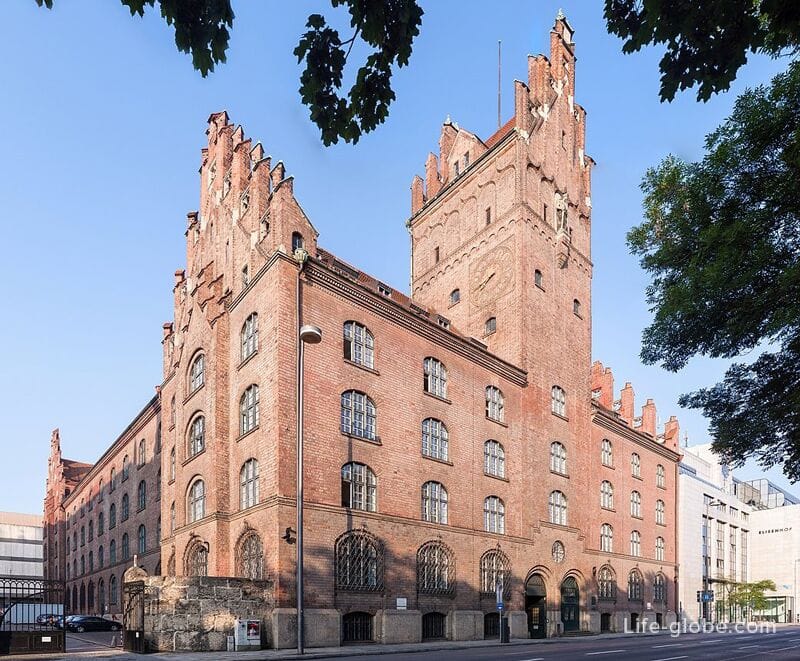
Gallery "Karstadt"
Gallery "Karstadt" (a Department store, "the station square Bahnhofplatz") - former Department store "Tietz".
Traditional Department store was built between 1904 and 1905 by Munich architect max Littmann with elements of the German Renaissance for the Department store Hermann Tietz.
Address: Bahnhofplatz, 7 (Bahnhofplatz). Website: galeria.de.
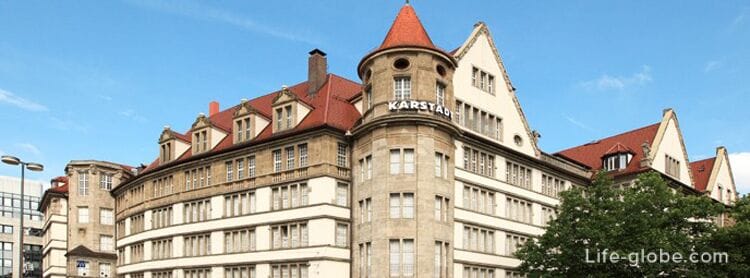
The Restaurant "Lowenbraukeller"
The restaurant "Löwenbräukeller" is one of the oldest, the largest and most famous beer halls of Munich, built by the brewery Löwenbräu.
The building is a pub was built from 1882 to 1883, in accordance with the plans of the architect albert Schmidt, and was officially opened on 14 June 1883.
In 1894, the facade of the tower was added.
From 1900, the year on stage Lowenbraukeller artists from around the world.
During the reconstruction in 1911, on the terrace in front of the main entrance was the sculpture of lion, which still looks after the restaurant.
After the destruction during the Second world war, in 1950 started the reconstruction of the building, which was upgraded all the rooms, and a large stage in the ballroom was moved to the Western part.
The restaurant has several rooms and a beer garden.
Address: Nymphenburger Strasse, 2 (Nymphenburger Strasse). Website: loewenbraeukeller.
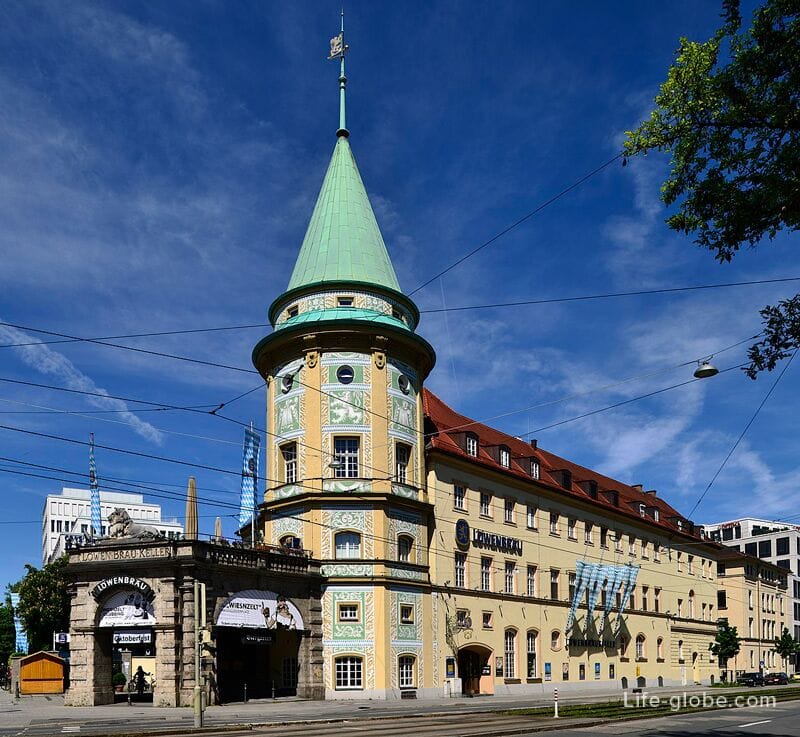
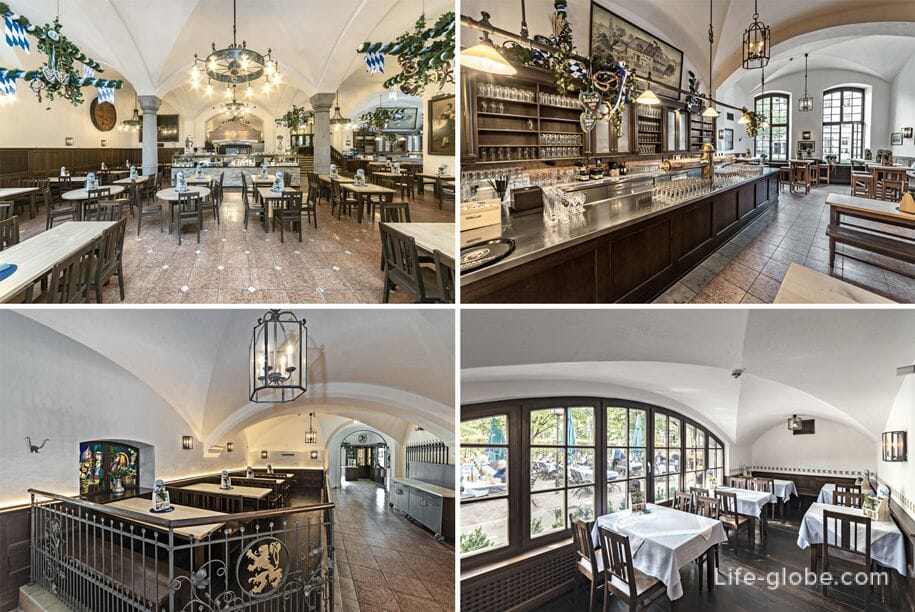
During the celebration of Oktoberfest in Munich, the tent Lowenbraukeller Stiglmaierplatz (Stiglmaierplatz) is a "small Oktoberfest", and for all those who do not want to go home after the official closing of Oktoberfest at 22:00 on the Theresienwiese, it is possible to go further and continue to have fun in the style of Oktoberfest in the main room with the terrace of the restaurant until the morning. Website: daswiesnzelt.
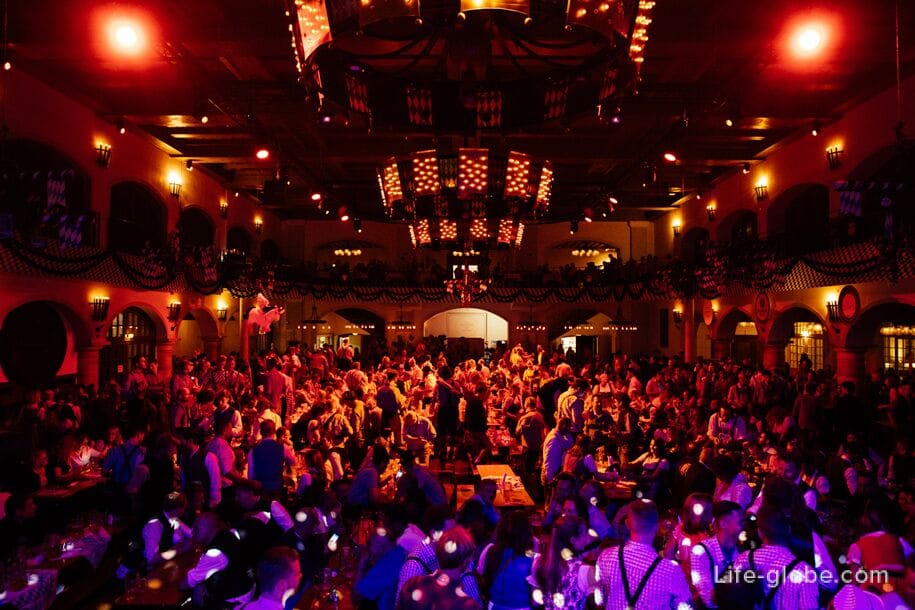
The Old "Simpl"
The old "Simpl" (Der Alte Simpl) - a historic restaurant and concert hall, existing since 1903.
Address: Turkenstrasse, 57 (Türkenstraße). Website: altersimpl.
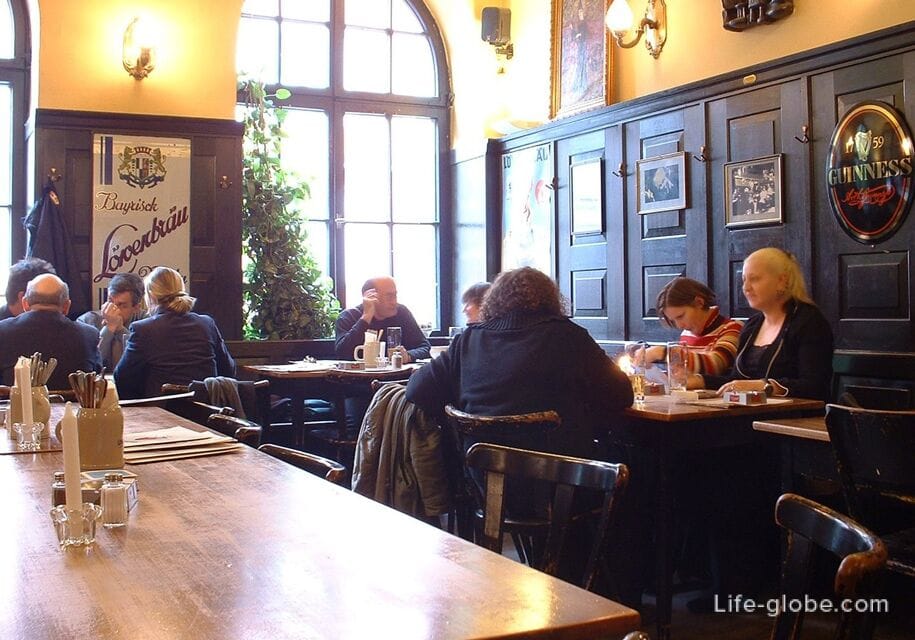
Beer garden "Augustiner-Keller"
Beer garden and restaurant "Augustiner-Keller" with a children's Playground is located in a historic building with adjoining territory.
The restaurant has several rooms and terraces, including a room in the former basement, which originally stored the beer. Beer garden for several thousand guests, is located outdoors near the building of the restaurant.
The institution has earned positive reviews from many locals and visitors alike. It's a pretty popular place - guests are often quite a lot.
The attention of the restaurant focuses on traditional Bavarian cuisine, which is complemented by international dishes, including light and vegetarian options.
Address: arnulfstr. underground station, 52 (Arnulfstraße) Website: augustinerkeller.
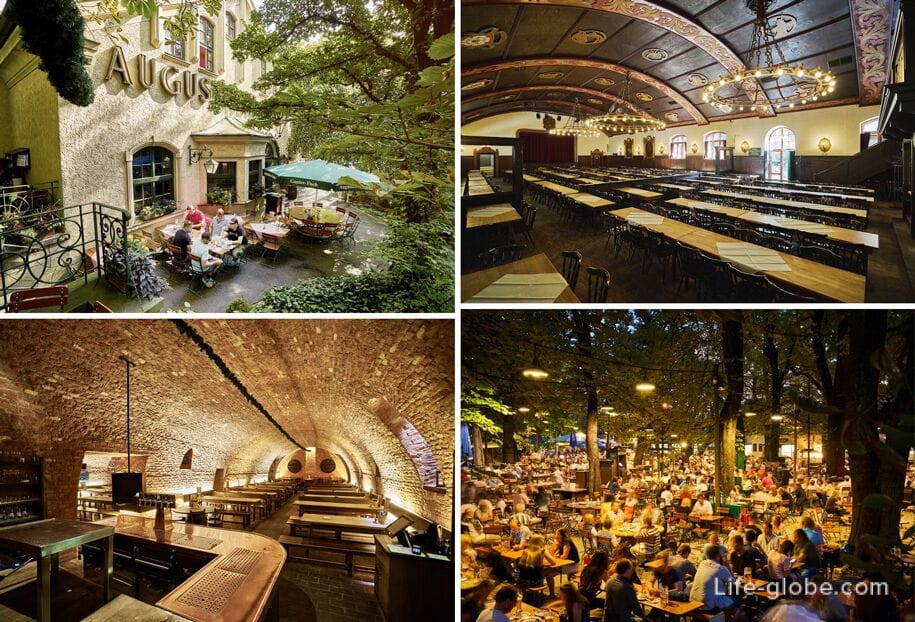
Abbey Of St. Boniface
The St. Boniface's Abbey (Abtei St. Bonifaz) is a Benedictine monastery founded in 1835 by king of Bavaria Ludwig I in the revival of the spiritual life of the country, by the restoration of monasteries destroyed during the secularization in the early 19th century.
The Abbey was built in the Byzantine style and formally opened in 1850.
The structure was destroyed during the Second world war and restored only partially.
The Church contains the tomb of king Ludwig I and his wife Queen Therese of Saxony-Hildburghausen.
Address: Karlstraße, 34 (Karlstraße).
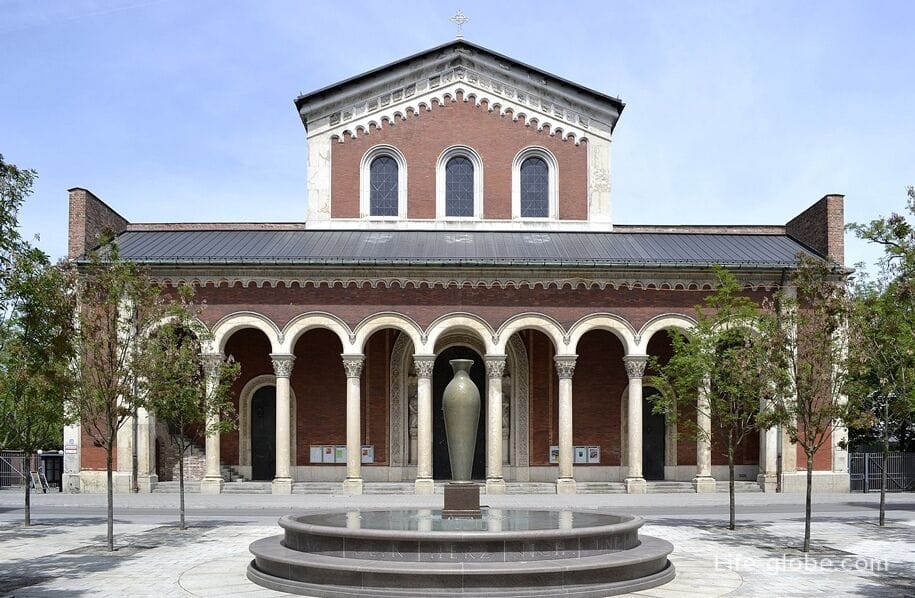
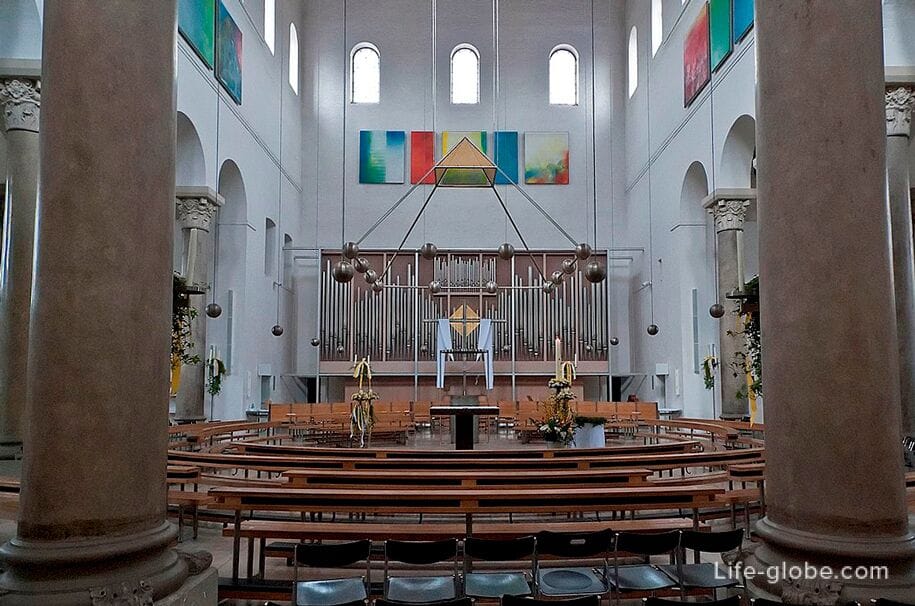
The Church of St. Joseph
St. Joseph's Church or Josefsberg (Kirche St. Joseph / Josephskirche) - the Roman Catholic Church, built in neo-Baroque style from 1898 to 1902.
The Church was large the first early Baroque Church in Munich.
From September 1913, the Shrine has long been a religious of the Capuchin Church.
The Church greatly suffered during the Second world war. Restoration work has been carried out since 1950.
Address: Josefsplatz, 1 (Josephsplatz).
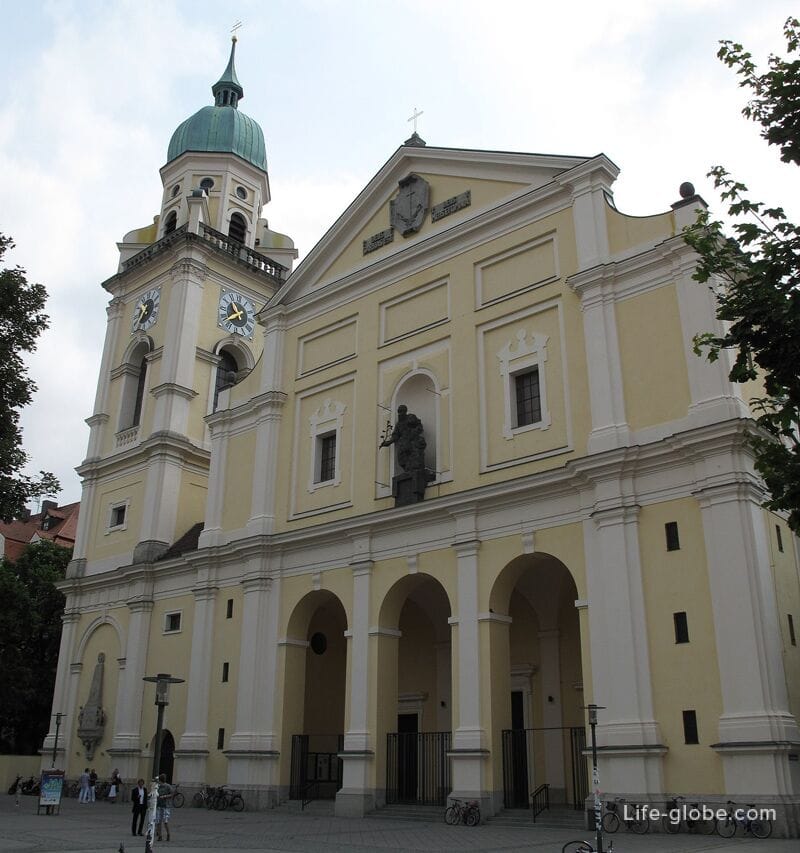
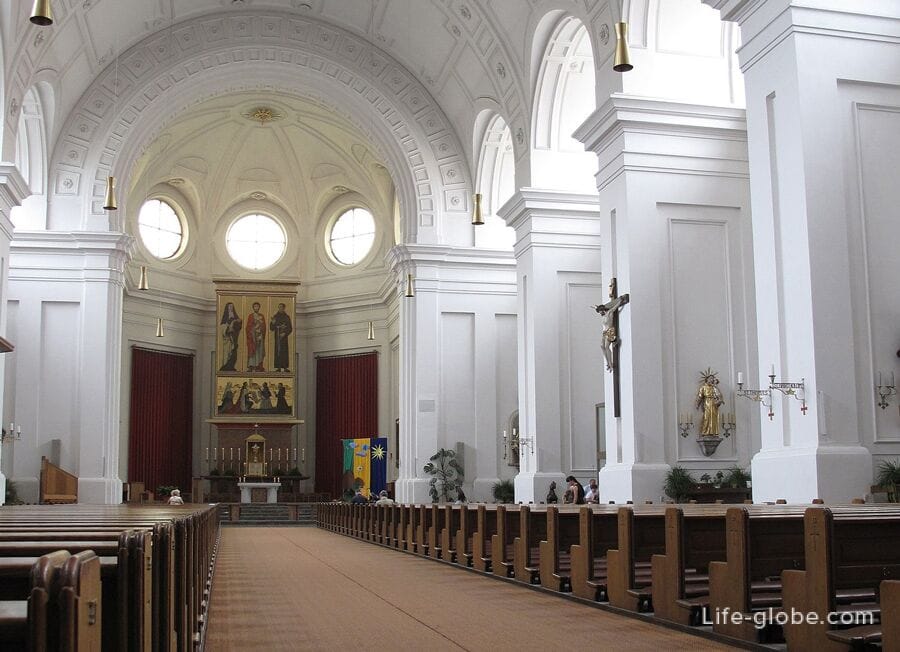
St. Mark's Church
The Church of St. Mark or Markuskirche (Kirche St. Markus / Markuskirche) is the second of the Evangelical Lutheran Church in Munich.
The original Church was built in 1873-1876 years, according to the plans of the architect Rudolf Gottgetreu.
The Church was damaged during the Second world war. Since 1955, underwent a major renovation, including existing wall constructions.
Address: Gabelsbergerstrasse, 6 (Gabelsbergerstraße).
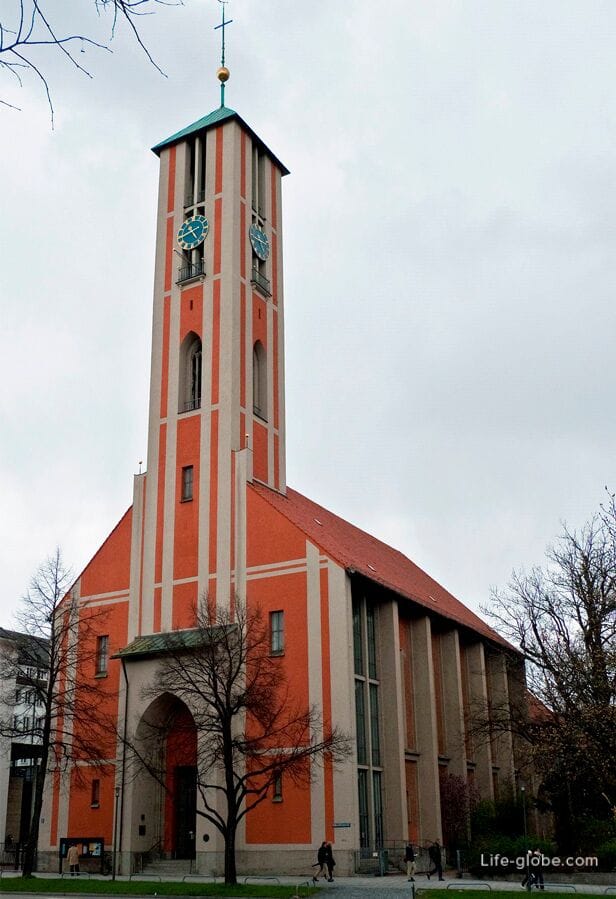
Church of St. Benno
Church of St. Benno (Kath. Pfarramt St. Benno / Saint Benno) is one of the most striking neo-Romanesque sacral buildings of the 19th century.
The Shrine was built from 1888 to 1895 according to the design of architect Leonhard Romeis in the style of Romanesque Revival.
The Catholic Church has considerable dimensions, and two tall towers located on both sides of the main portal.
Address: Linisteste, 21 (Loristraße).
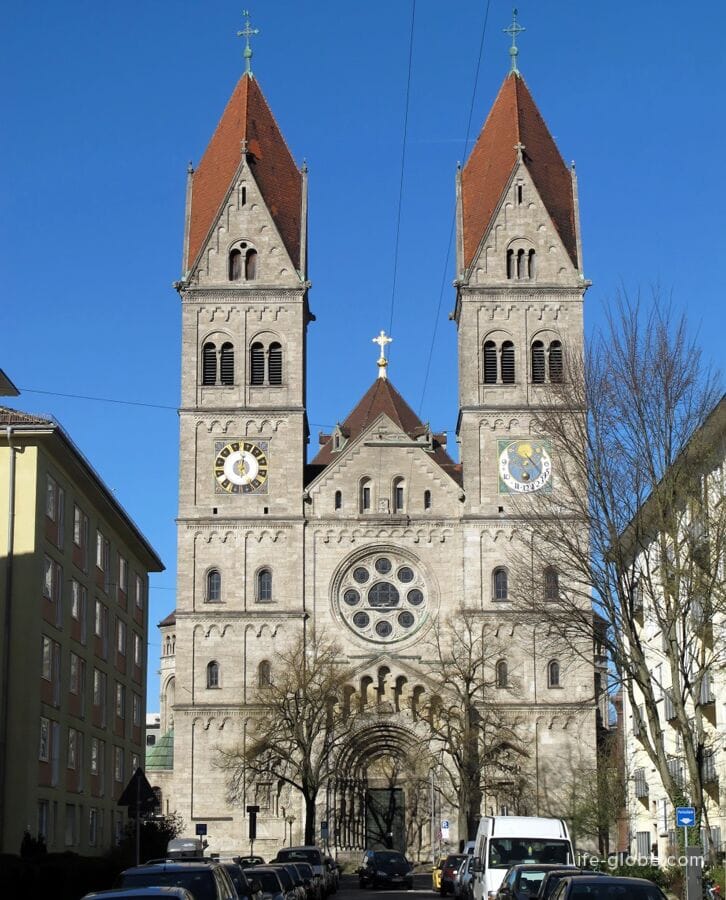
Church office
Church office (Landeskirchenamt München) is the administrative headquarters of the Evangelical Lutheran Church in Bavaria.
The office consists of several connected buildings on the street Katharina-von-Bora-straße 7-13 (Katharina-von-Bora-Straße).
The architect Oswald Bieber and Karl Stehr has built administrative building in the form of an Italian Palazzo, from 1928 to 1929.
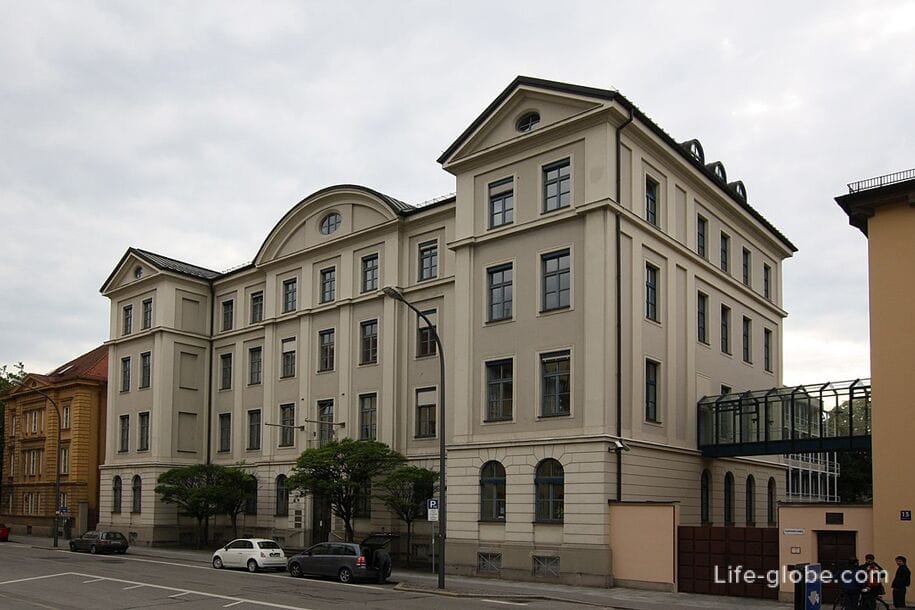
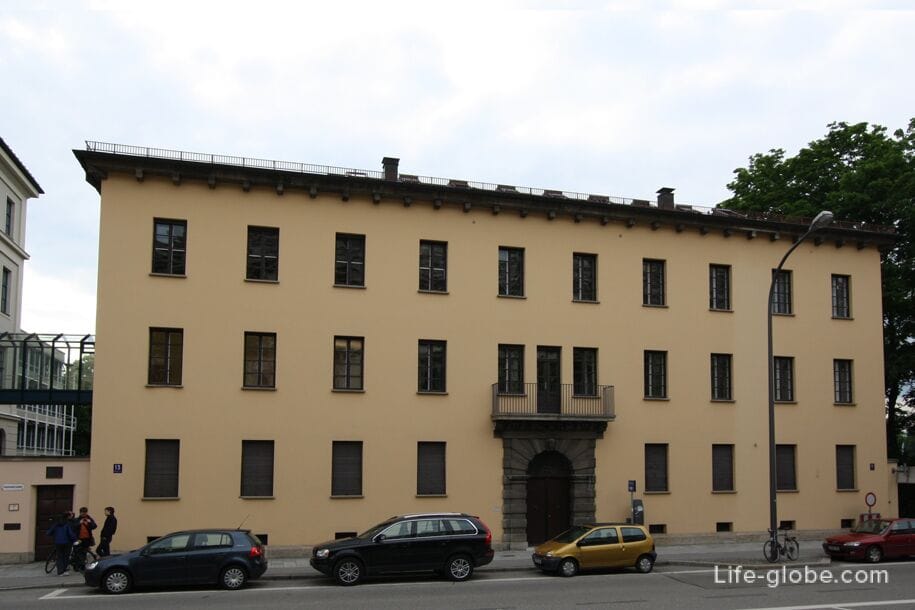
Circus "Krone"
Circus "Krone" (Circus Krone / Kronebau) originates from the year 1900, when Karl Kron inherited a wandering menagerie of his father ("Menagerie Continental"), which year-round was moving across Europe.
By 1905, Kron and his wife IDA Ahlers turned the zoo into a circus, creating it as a "Circus Krone".
The first wooden circus building in Munich was built in 1919.
The circus was several times leased the Nazi party, including Adolf Hitler said the 7 speeches in the building between 1920 and 1930.
During the Second world war the building was destroyed. In 1945, it was built a temporary wooden structure at 1800 seats.
The third and current circus building was constructed using reinforced concrete foundations and brick walls and opened in 1962, in the form of a multifunctional building with a capacity of 3,000.
The Krone circus is a building for his winter circus program each year is traditionally from December to early April. In the remaining months of the year, the circus acts in some cities of Europe, and the circus building in Munich for rent as a multi-purpose venue entertainment and corporate events.
Address of the circus: Marsstrasse, 43 (Marsstraße). The website of the circus: circus-krone.

Memorial "8 November 1939"
Memorial "8 November 1939" (8 November 1939) - the name of the memorial to Johann Georg Altera, which was built to commemorate the resistance fighters fighting against the Nazis.
Johann Georg Elser (4 January 1903 - 9 April 1945) was a German carpenter who planned and carried out an elaborate assassination attempt of Adolf Hitler and other senior Nazi leaders. 8 Nov 1939 in beer Burgerbraukeller (Bürgerbräukeller) in Munich. The attempt called "the bombing of the Bürgerbräukeller".
To prepare for the murder of Elser moved to Munich in the summer of 1939.
Elser constructed and planted the bomb near the platform in the beer hall "Burgerbraukeller" with which Hitler was to speak. However, this did not kill Hitler because he died earlier than expected, but it killed 8 people and wounded 62 people. Elser was arrested and was confined for more than five years until he was executed in the Dachau concentration camp, less than a month before the surrender of Nazi Germany.
The current monument is located near the former place, where he rented a room of Alter.
The monument was designed by the German artist Mrs. Wagner. Made of aluminum and glass and installed on the facade of the building in a circle, and thus that the elements of the label, "8 November 1939" the visual image explosion. Every evening at 21:20 (exact time of the bombing) numbers and letters of the memorial are illuminated one after the other until you covered the whole thing. The indicators remain on for a minute, and then back off.
Address of memorial: Turkenstrasse, 68 (Türkenstraße).
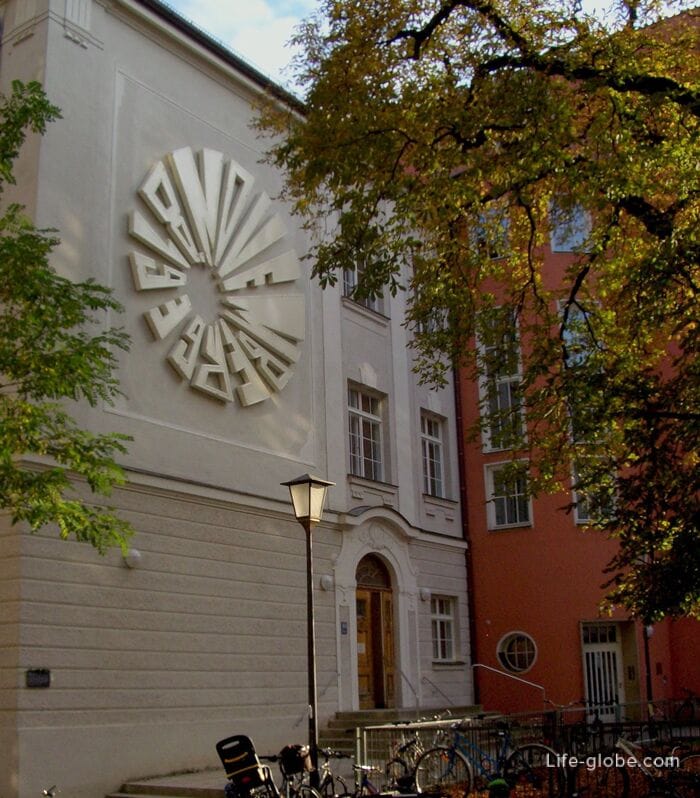

Fountain Nornen
Fountain Nornen (Nornenbrunnen / Arnebrant) was built in 1907 by the project of Hubert of Netzero in the art Nouveau style.
Fountain made of limestone and depicts the Norns - the three Germanic goddesses of fate and people (Urðr fate, Verdandi the present and Skuld - debt or future) that rely on a large upper bowl of water. Between the figures there are three holes from which the water flows in three shallow bowls pools.
At its present location, the fountain was installed in 1965.
The fountain is located on the border of Maxvorstadt and Munich's old town (North-West side Maximiliansplatz / Maximiliansplatz).
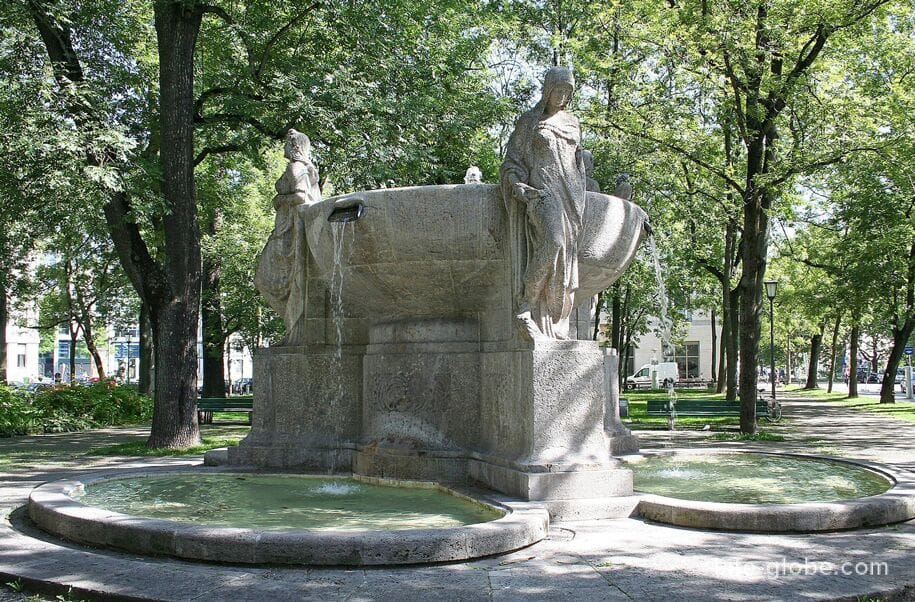
The Fountain Of The Dolphins
The fountain of Dolphins (Delphinbrunnen / Delfinen) depicts a male figure, riding a big fish, mustache and open mouth that drain the water jets in the reservoir of the fountain.
The fountain is located at the confluence of the streets Augustenstrasse (Augustenstraße) and Dachauer straße (Dachauer Straße).
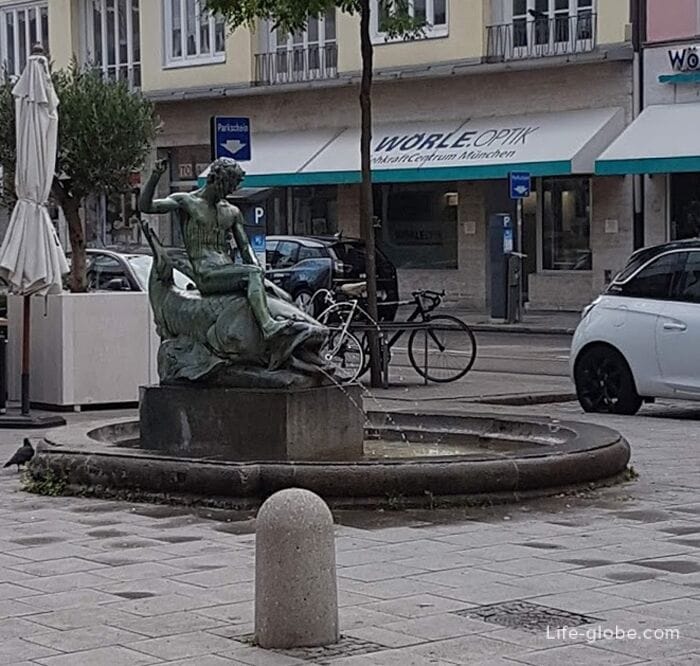
Old North cemetery
Old North cemetery (Nordfriedhof, Alte) was built in 1866 according to the plans of architect and city Councilman Arnold, Zenetti.
Was used for burials between 1869 and 1944-1945.
In the postwar years, it was decided no longer to "open" the old North cemetery. Many graves have been cleaned. Of the total capacity 7272 graves, only 700 survived to the present time.
Today the cemetery is used as a green area (a small Park) and as part of piety towards people buried here long ago.
In the Park benches, and instead of the sanctuary, now there is a Playground, separated from the rest of the cemetery. Near the Playground a Playground for ball games and places to play chess (the Western edge of the old cemetery).
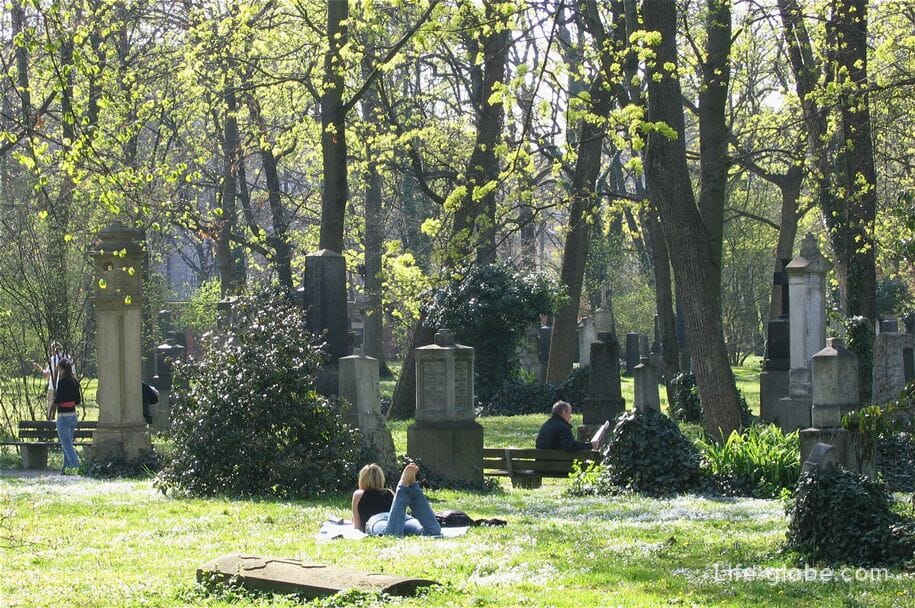
The location of Maxvorstadt
District Maxvorstadt near the North-Western part of Munich's Old town. The Eastern boundary of the district runs near the English garden. In the North the district borders with the district of Schwabing (Schwabing-West). To the West of the district Neuhausen-Nymphenburg (Neuhausen-Nymphenburg). In the South-West district of Munich (Schwanthalerhöhe). To the South the heart of Munich-Isarvorstadt (Munich-Munich).
At the South-Western border of Maxvorstadt is the Central bus station in Munich (Zentraler Omnibusbahnhof München), close to the train station (München Hbf).
In the center are subway lines, are also tram and bus stops.
District Maxvorstadt on the map
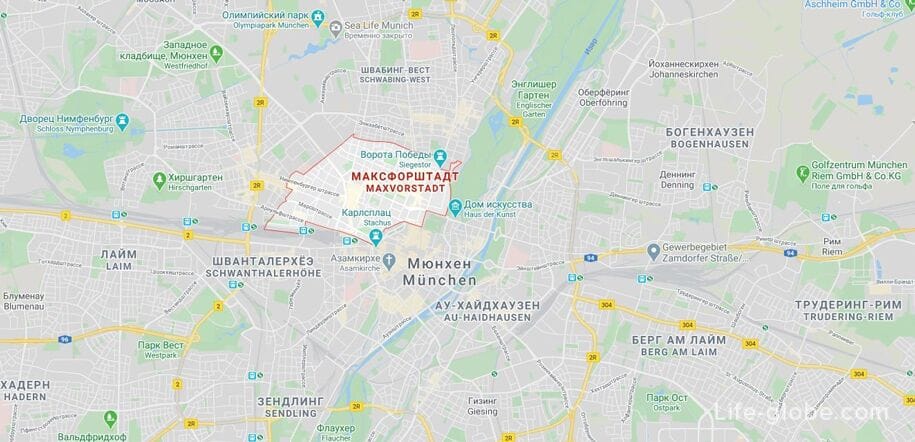
Where to stay in Maxvorstadt
5-star Rocco Forte The Charles hotel overlooking the old Botanical garden.
In the hotel: Spa with indoor pool, sauna, steam bath and fitness room; soundproof rooms with free Wi-Fi; restaurant; bistro with a terrace and a bar; a private garage.
The rooms and suites: air conditioning, flat-screen TV, a bathroom with bath and separate shower. Link to the hotel
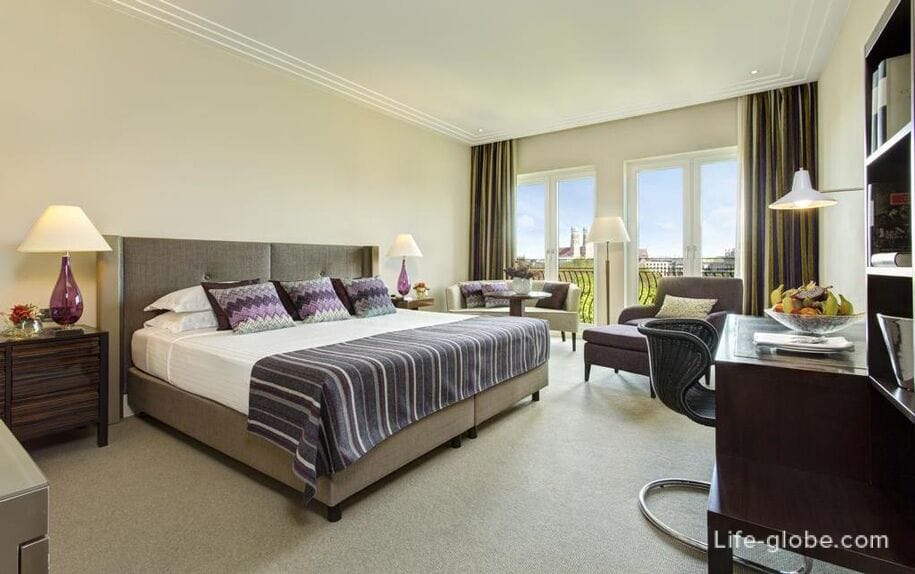
4-star hotel with restaurant and bar on-site Parking, terrace, garden, bar, free Wi-Fi and private Parking.
The Soundproofed rooms: modern furniture, air conditioning, flat-screen TV, safe, mini-bar, electric kettle and a writing Desk. The private bathroom includes a shower, Hairdryer and free toiletries.
Room rates may include Breakfast. Link to the hotel
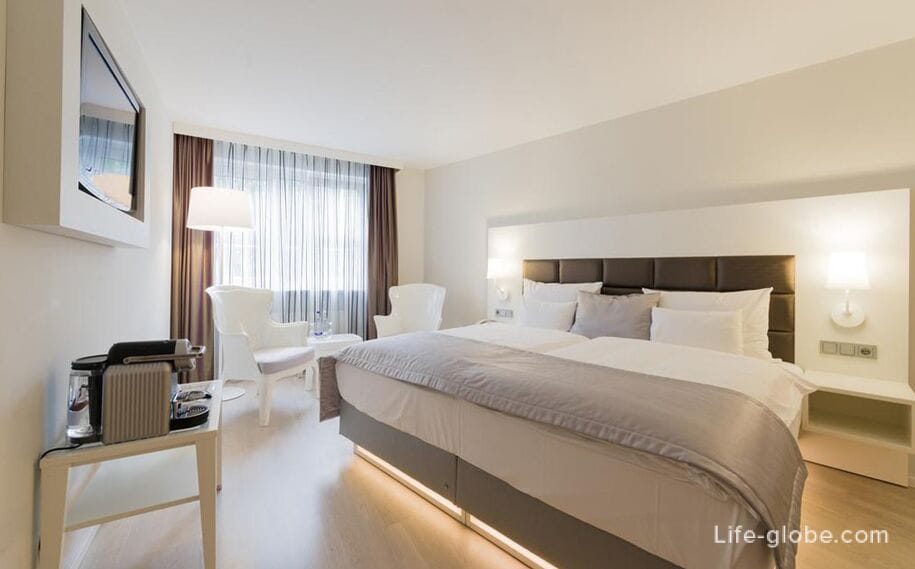
The 3-star hotel Hauser an der Universität with free Wi-Fi, free Parking and a small Spa area with a sauna.
In the rooms: vulneravility Windows, satellite TV and air conditioning. The bathrooms have Hairdryers.
Room rates include Breakfast. Link to the hotel

The family-run hotel Antares with Parking and Wi-Fi throughout.
The rooms: the flat-screen TV, soundproof Windows and doors. The private bathroom has a Hairdryer.
Room rates include Breakfast. Link to the hotel

Villa Amenity - Residenz am Englischen Garten offers a shared lounge, a garden, barbecue facilities and a terrace.
From the Windows overlooking the garden.
Villa: 6 bedrooms, a flat-screen satellite TV, a fully equipped kitchen with a dishwasher and a microwave, a washing machine and a bathroom with shower. Link to the Villa
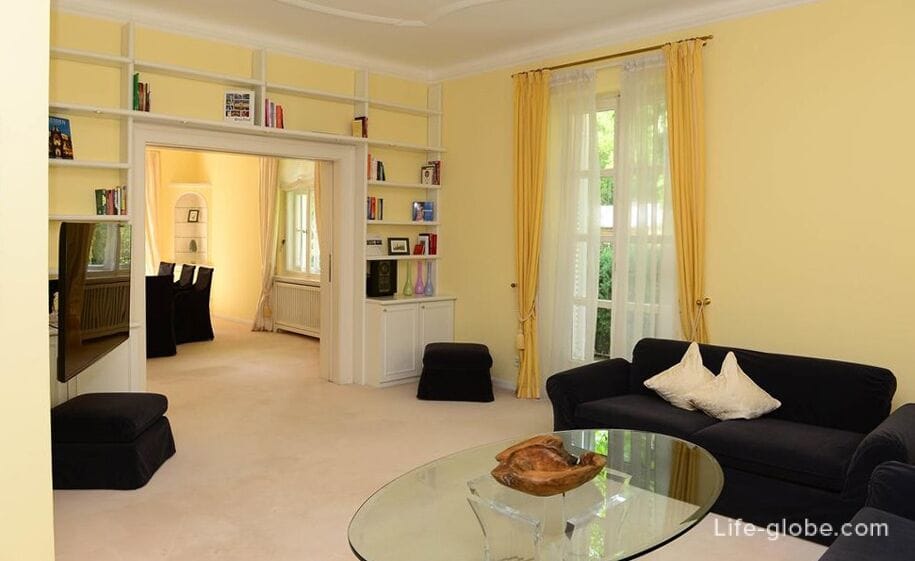
Premium apartment downtown/Arts District with free Wi-Fi, wooden floors, contemporary furnishings and Parking.
The apartment: living area with a flat-screen TV, iPod dock, fully equipped kitchen with a dishwasher and coffee machine, washing machine. The link apartments
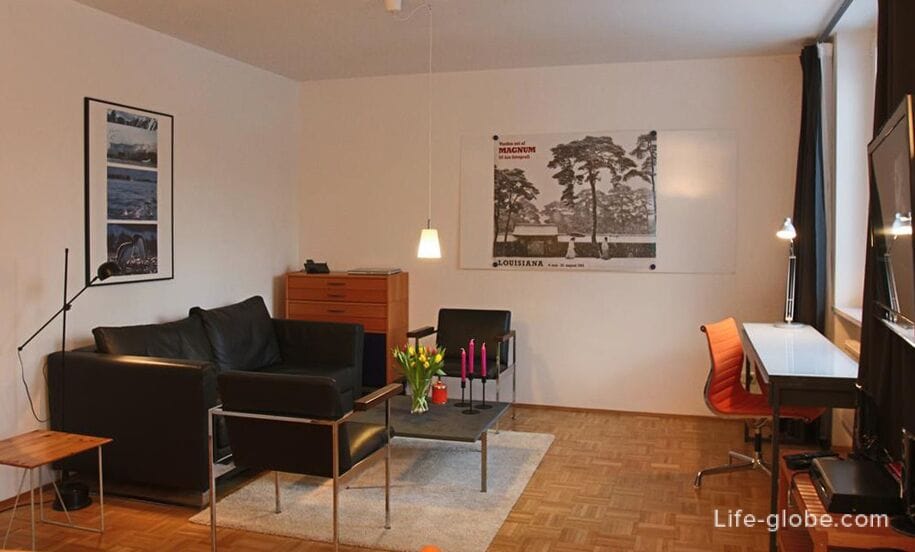
All accommodation in Munich, including in the district of Maxvorstadt in the city centre, you can view and book here








